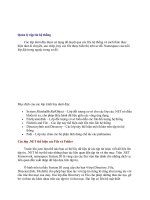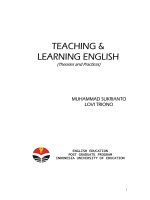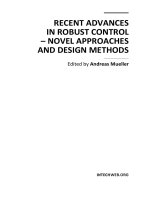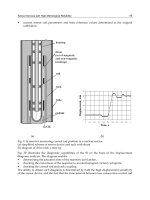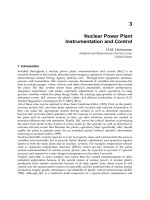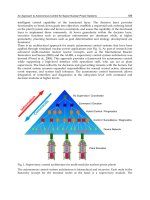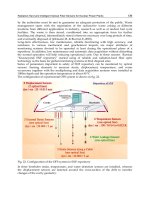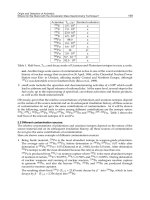Nuclear Power Control, Reliability and Human Factors Part 1 pdf
Bạn đang xem bản rút gọn của tài liệu. Xem và tải ngay bản đầy đủ của tài liệu tại đây (641.9 KB, 30 trang )
NUCLEAR POWER –
CONTROL, RELIABILITY
AND HUMAN FACTORS
Edited by Pavel V. Tsvetkov
Nuclear Power – Control, Reliability and Human Factors
Edited by Pavel V. Tsvetkov
Published by InTech
Janeza Trdine 9, 51000 Rijeka, Croatia
Copyright © 2011 InTech
All chapters are Open Access articles distributed under the Creative Commons
Non Commercial Share Alike Attribution 3.0 license, which permits to copy,
distribute, transmit, and adapt the work in any medium, so long as the original
work is properly cited. After this work has been published by InTech, authors
have the right to republish it, in whole or part, in any publication of which they
are the author, and to make other personal use of the work. Any republication,
referencing or personal use of the work must explicitly identify the original source.
Statements and opinions expressed in the chapters are these of the individual contributors
and not necessarily those of the editors or publisher. No responsibility is accepted
for the accuracy of information contained in the published articles. The publisher
assumes no responsibility for any damage or injury to persons or property arising out
of the use of any materials, instructions, methods or ideas contained in the book.
Publishing Process Manager Petra Zobic
Technical Editor Teodora Smiljanic
Cover Designer Jan Hyrat
Image Copyright Ensuper, 2010. Used under license from Shutterstock.com
First published September, 2011
Printed in Croatia
A free online edition of this book is available at www.intechopen.com
Additional hard copies can be obtained from
Nuclear Power – Control, Reliability and Human Factors, Edited by Pavel V. Tsvetkov
p. cm.
ISBN 978-953-307-599-0
free online editions of InTech
Books and Journals can be found at
www.intechopen.com
Contents
Preface IX
Part 1 Instrumentation and Control 1
Chapter 1 Sensor Devices with High Metrological Reliability 3
Kseniia Sapozhnikova and Roald Taymanov
Chapter 2 Multi-Version FPGA-Based Nuclear
Power Plant I&C Systems: Evolution of Safety Ensuring 27
Vyacheslav Kharchenko, Olexandr Siora and Volodymyr Sklyar
Chapter 3 Nuclear Power Plant Instrumentation and Control 49
H.M. Hashemian
Chapter 4 Design Considerations for the Implementation of
a Mobile IP Telephony System in a Nuclear Power Plant 67
J. García-Hernández, J. C. Velázquez- Hernández,
C. F. García-Hernández and M. A. Vallejo-Alarcón
Chapter 5 Smart Synergistic Security
Sensory Network for Harsh Environments: Net4S 85
Igor Peshko
Chapter 6 An Approach to Autonomous
Control for Space Nuclear Power Systems 101
Richard Wood and Belle Upadhyaya
Chapter 7 Radiation-Hard and Intelligent
Optical Fiber Sensors for Nuclear Power Plants 119
Grigory Y. Buymistriuc
Chapter 8 Monitoring Radioactivity
in the Environment Under
Routine and Emergency Conditions 145
De Cort Marc
VI Contents
Chapter 9 Origin and Detection
of Actinides: Where Do We Stand
with the Accelerator Mass Spectrometry Technique? 167
Mario De Cesare
Part 2 Reliability and Failure Mechanisms 187
Chapter 10 Evaluation of Dynamic J-R Curve for Leak Before
Break Design of Nuclear Reactor Coolant Piping System 189
Kuk-cheol Kim, Hee-kyung Kwon, Jae-seok Park and Un-hak Seong
Chapter 11 Feed Water Line
Cracking in Pressurized Water Reactor Plants 207
Somnath Chattopadhyay
Chapter 12 Degradation Due to Neutron
Embrittlement of Nuclear Vessel Steels:
A Critical Review about the Current Experimental
and Analytical Techniques to Characterise the Material,
with Particular Emphasis on Alternative Methodologies 215
Diego Ferreño, Iñaki Gorrochategui and Federico Gutiérrez-Solana
Chapter 13 Corrosion Monitoring
of the Steam Generators of V-th and
VI-th Energy Blocks of Nuclear Power Plant “Kozloduy” 239
Nikolai Boshkov, Georgi Raichevski, Katja Minkova and Penjo Penev
Chapter 14 Collapse Behavior
of Moderately Thick Tubes Pressurized from Outside 257
Leone Corradi, Antonio Cammi and Lelio Luzzi
Chapter 15 Resistance of 10GN2MFA-A Low Alloy Steel to
Stress Corrosion Cracking in High Temperature Water 275
Karel Matocha, Petr Čížek, Ladislav Kander and Petr Pustějovský
Part 3 Component Aging 287
Chapter 16 Aging Evaluation for the Extension of
Qualified Life of Nuclear Power Plant Equipment 289
Pedro Luiz da Cruz Saldanha and Paulo Fernando F. Frutuoso e Melo
Chapter 17 Non-Destructive Testing for
Ageing Management of Nuclear Power Components 311
Gerd Dobmann
Part 4 Plant Operation and Human Factors 339
Chapter 18 Human Aspects of NPP Operator Teamwork 341
Márta Juhász and Juliánna Katalin Soós
Contents VII
Chapter 19 The Human Factors Approaches
to Reduce Human Errors in Nuclear Power Plants 377
Yong-Hee Lee, Jaekyu Park and Tong-Il Jang
Chapter 20 Virtual Control Desks for Nuclear Power Plants 393
Maurício Alves C. Aghina, Antônio Carlos A. Mól,
Carlos Alexandre F. Jorge, André C. do Espírito Santo,
Diogo V. Nomiya, Gerson G. Cunha, Luiz Landau,
Victor Gonçalves G. Freitas and Celso Marcelo F. Lapa
Chapter 21 Risk Assessment in Accident Prevention
Considering Uncertainty and Human Factor Influence 407
Katarína Zánická Hollá
Preface
Due to economic growth and increasing population, energy demands must be satisfied
in a sustainable manner assuring inherent safety, efficiency and minimized
environmental impact. Nuclear power has long posed a dilemma for
environmentalists and scientists alike. On the one hand it is seen as a cheap, clean
energy source whilst on the other some have concerns over its ability to dispose of
radioactive waste. Whichever viewpoint one may assume, nuclear power is at the
forefront of clean energy technology and can be made available on a large scale to
meet energy needs of the rapidly growing world.
Today’s nuclear reactors are safe and highly efficient energy systems that give
electricity and a multitude of co-generation energy products ranging from potable
water to heat for industrial applications. Meanwhile, a catastrophic earthquake and a
tsunami in Japan led to the nuclear accident that forced us to rethink our approach to
nuclear safety and design requirements. It also encouraged the growing of interest for
advanced nuclear energy systems and next generation nuclear reactors, inherently
capable of withstanding natural disasters, avoiding catastrophic consequences and
leaving no environmental impact. Advances in reactor designs, materials and human-
machine interfaces assure safety and reliability of emerging reactor technologies,
eliminating possibilities for high-consequence human error, such as those which have
occurred in the past. New instrumentation and control technologies based in digital
systems, novel sensors and measurement approaches facilitate safety, reliability and
economic competitiveness of nuclear power options.
Autonomous operation scenarios are becoming increasingly popular to consider for
small modular systems designed for remote regions with limited industrial
infrastructure or regions with no such infrastructure but with human population
whose safety, prosperity and growth depend on a reliable energy supply.
This book is one in a series of books on nuclear power published by InTech. It consists
of four major sections and contains twenty-one chapters on topics from key subject
areas pertinent to instrumentation and control, operation reliability, system aging and
human-machine interfaces.The book opens with the section on instrumentation and
control aspects of nuclear power. The following sections and included chapters
address selected issues in reliability and failure mechanisms, component aging, plant
X Preface
operation and human factors. The book shows both advantages and challenges
emphasizing the need for further development and innovation.
With all diversity of topics in 21 chapters, the issues of nuclear power control,
reliability and human factor represent a common thread that is easily identifiable in all
chapters of the book. The “systems thinking” approach allows synthesizing the entire
body of provided information into a consistent integrated picture of the real-life
complex engineering system – nuclear power system – where everything works
together.
The goal of this book and the entire book series on nuclear power is to present nuclear
power to our readers as a promising energy source that has a unique potential to meet
energy demands with minimized environmental impact, near-zero carbon footprint,
and competitive economics via robust potential applications.
The book targets a broad potential readership group - students, researchers and
specialists in the field - who are interested in learning about nuclear power. The idea is
to facilitate intellectual cross-fertilization between field experts and non-field experts
taking advantage of methods and tools developed by both groups. The book will
hopefully inspire future research and development efforts, innovation by stimulating
ideas.
We hope our readers will enjoy the book and will find it both interesting and useful.
Pavel V. Tsvetkov
Department of Nuclear Engineering
Texas A&M University
United States of America
Part 1
Instrumentation and Control
1
Sensor Devices with
High Metrological Reliability
Kseniia Sapozhnikova and Roald Taymanov
D.I.Mendeleyev Institute for Metrology,
Russia
1. Introduction
At present, a great number of embedded sensor devices provide monitoring of operating
conditions and state of equipment, including nuclear reactors of power plants. The
metrological reliability of measuring instruments built in equipment determines the validity
of measurement information. The quality of production, operating costs, and the probability
of accidents depend on the validity of measurement information coming to control systems.
The validity is particularly important in such fields as nuclear power engineering,
cosmonautics, aviation, etc. For some products in definite periods of their operation, even a
short-term loss of confidence in measurement accuracy is unacceptable.
The key problems of the measurement information validity are related to the sensor
metrological reliability, since their components age and their parameters drift with time.
Sudden failures can also happen. All this can result in control errors. The sensor devices
used to monitor the condition of technological equipment and the parameters of a
technological process, are, as a rule, subject to a variety of influencing quantities. Possible
consequences of these influences are, for example, depositions, magnetization, and so on. In
some cases, the effect of the influence quantity can be weakened by a careful design of the
sensor. For example, the rate of fouling of a sensor surface can be reduced by polishing the
surface. However, it is not always possible to develop a sensor device immune to
influencing factors over a long period of operation. Sometimes, economic reasons may play
a role as well.
At present, the traceability of measurements is provided by periodic calibrations or
verifications (hereinafter both of these procedures will be referred to as calibrations).
Accordingly, within the period of operation the probability of a metrological failure
depends on the length of the calibration interval (CI). The state of a secondary transducer
can be verified by supplying electrical signals of reference values to its inputs. As
demonstrated in (Fridman, 1991), between 40% and 100% of all measuring instrument
failures are due to metrological failures. Improvements in production quality result in
decrease of the number of failures, the share of metrological failures being increased because
with the technology improvement the share of sudden failures decreases. It is not expedient
to apply fundamental assumptions of the classical reliability theory (e.g., mutual
independence of failure rates and stability of a failure rate) to measuring instruments. Usage
of methods based on these assumptions leads to crude errors in the CI determination.
To decrease the risk of getting unreliable information, usually the CI is no more than 2-3
years. However, the cost of a sensor device calibration is typically 35–300 euro, and the
Nuclear Power – Control, Reliability and Human Factors
4
number of sensor devices is growing year by year. If a CI duration is constant, the
proportion of operating costs spent on calibration will rise to an unacceptable level. In many
cases, it is necessary to disrupt a technological process in order to carry out sensor device
calibration. Such interference leads to additional costs.
The standard (ISO/IEC, 1999) states that it is ‘‘the responsibility of the end-user
organization to determine the appropriate calibration interval under the requirements of its
own quality system”. The guidelines (OIML, 2007) state that ‘‘the initial decision in
determining the CI is based on the following factors:
instrument manufacturer’s recommendation;
expected extent and severity of use;
the influence of the environment;
the required uncertainty in measurement;
maximum permissible errors (e.g., by legal metrology authorities);
adjustment of (or change in) the individual instrument;
data about the same or similar devices, etc.”
Furthermore, it is recommended to adjust the initial CI for the process of operation ‘‘in order
to optimize the balance of risks and costs”, due to a number of reasons, for example:
the instruments may be less reliable than expected;
the operating conditions may vary significantly from the manufacturer’s recommended
ranges, requiring an adjustment to the CI;
the level of drift determined by instrument recalibration can demonstrate that longer
CIs are possible without any increase of risk;
it may be sufficient to carry out a limited calibration of certain instruments instead of a
full calibration, etc.
However, in some cases, it is impossible to perform calibrations with a short CI, in order to
obtain the data necessary for adjusting the CI value for the measuring instrument. For many
modern complex technical processes, the mean value of continuous running grows. At
present, for some processes the campaign duration has to be no less than 10 years.
Measuring instrument operation conditions can vary considerably over the course of
several CIs. In industrial equipment, they can appreciably vary when upgrading the
technological process, e.g., in case of production modernization. Operation conditions
for sensor devices in ship nuclear power sets will depend on the intensity of the
equipment use. For all the reasons given above, the end user does not want or has no
possibility of affording the testing of each measuring instrument in order to provide
grounds for optimizing the CI. Calibrations are expensive, but as the experience shows,
the majority of measuring instruments (according to various estimates which vary from
60% to 80% for all instruments submitted for calibrating) does not need it. However,
approximately 12% of measuring instruments have an error exceeding the permissible
limits within the CI.
The contradiction is obvious. To reduce the costs associated with the interruption of a
technological process and the calibration of built-in measuring instruments, it is desirable to
calibrate as seldom as possible. However, unreliable information received by a control
system from measuring instruments, can cause failures and large economic losses. To
prevent this, it is necessary to check the measuring instrument state as often as possible.
It is impossible to settle this contradiction using trivial methods of calibration.
Sensor Devices with High Metrological Reliability
5
This chapter deals with non-conventional methods of improvement of the measuring
information validity and possibilities to increase the sensor device metrological reliability
on the basis of these methods.
2. Way to solve the problem. Self-check in biological and technical sensor
systems
Various attempts have been made to decrease the labour costs of instrument calibration: in
some cases calibration is performed without dismantling the sensor. For example, in
(Karzhavin et al., 2007) it was proposed to design the thermocouple housing with an
additional hole and to periodically insert a thin reference thermocouple into this hole. Such
periodical sensor calibration procedures are an additional load for personnel. They may
result in bending or damaging of the thermocouples or sensor displacement from the
required location. All these undesirable outcomes may result in calibration errors.
In some sensors, a ‘‘live zero” correction is made. For example, in a pressure sensor this can
be performed by ‘‘switching off” the pressure measured. However, such a procedure does
not reveal and correct a multiplicative error.
Both of the above proposals cannot ensure checking the ‘‘metrological health‘‘ of a sensor
within the CI.
One possible solution of the problem is suggested by taking into account the qualitative
difference in the goals which metrologists try to achieve at various stages of the life cycle of
a measuring instrument. The initial calibration of a sensor on completion of its manufacture
is aimed at establishing and specifying the parameters corresponding to a ‘‘normal
condition” of the sensor. At the stage of online operation, the goal is different. It consists in
revealing a metrological failure, i.e. deviation of the parameters from their initial values
registered at the initial calibration, and, if possible, in correcting them. This goal can be
achieved using unconventional methods.
In order to find possible ways to solve a problem it is necessary to have a criterion. Professor
Wiener (Wiener, 1948) and the outstanding philosopher and writer Mr. Lem (Lem, 1980)
demonstrated the value of applying an analogy between technical and biological systems.
This analogy is very successfully being developed in evolutionary cybernetics (Red’ko, 2007;
Turchin, 1977), as well as in bionics (biomimetics). As applied to sensors, a biomimetic
approach enables to realize functions, structural elements and other features which mimic
similar designs ‘‘discovered” by nature in the past (Bogue, 2009; Stroble et al, 2009).
In our opinion, the similarity between the biological and technical evolutions forms not only
a ‘‘reference book” containing successful structural and functional decisions. In the case of
metrology, it gives a necessary strategic criterion for development of measuring instruments
and systems with high metrological reliability.
The time scales of biological evolution and of sensor device development are different.
However, the tasks solved were similar: with time, the methods providing the survival in
the nature and the methods providing metrological reliability of sensor devices built in the
equipment intended to be used under changing environmental conditions, were improved.
In the early period, prolonging of life was achieved through the use of conservative methods
of enhancing the “reliability”. For example, protection of a turtle with a shell or protection of
a sensor device with a sheath, certainly could prolong their life span.
However, the ambient conditions of measuring instruments as well as those of living
organisms are characterized by a significant level of unpredictability. Adaptive methods
Nuclear Power – Control, Reliability and Human Factors
6
allow to take into account the variability of the environment (Taymanov & Sapozhnikova,
2010b). The adjustment of the insulating properties of an animal’s pelt with the season
increases the likelihood of survival under a changing environment, as does the active
thermoregulation of measuring instruments.
The appearance and growth of biological intelligence relate to ensuring the survival under
increasingly rapid environmental changes. Intelligence enables to forecast and take into
account future changes of dangerous character, including those of an intelligence carrier
state. ‘‘Evolutionary change is not a continuous thing; rather it occurs in fits and starts, and
it is not progressive or directional‘‘. On the other hand, evolution ‘‘has indeed shown at
least one vector: toward increasing complexity‘‘ (McFarland, 1999).
Developing the idea of the analogy between biological and technical evolution, it is possible
to consider a direct analogy between the life span of a living organism and the lifetime of a
measuring instrument, during which the measuring instrument is characterized by
metrological serviceability and the absence of any maintenance requirement.
Then the purpose of artificial intelligence in a measuring instrument can be defined as
ensuring the reliability of measurements for an extended lifetime. To achieve this ultimate
purpose, it is necessary to analyze ‘‘metrological health”, to forecast future ‘‘behavior”, as
well to provide a correction of an error and self-recovery of a measuring instrument.
The idea of applying ‘‘intelligence” for increasing the reliability of measurement
information formed by measuring instruments, appeared and started developing not long
time ago. At this stage of technical evolution, it became necessary to extend considerably the
lifetime of the ‘‘weak points‘‘ of measurement instruments. These ‘‘weak points‘‘ are sensor
devices. At the same time, it became possible to solve this problem at the expence of the
increase in the complexity of a sensor device.
Intelligence in the nature has developed in two ways: the formation of a ‘‘collective mind”
consisting of many living organisms, and the development of the intelligence (mind) of a
separate individual. If the risk of extinction of individual living organisms is high, the
‘‘collective mind” provides a way of preserving the experience gained and supporting the
life of the species as a whole. Certainly, just such a type of intelligence started forming at the
early stages of evolution, when the life span of an individual organism was short. A
representative example is given by the swarming insects, i.e., the bees, which select reliable
information by ‘‘voting”. The validity of information obtained by scout bees, depends on the
number of bees obtained this information.
Formation of the ‘‘collective mind” is the integration of a number of autonomous
subsystems at a lower level (they can be different, to some extent) and the development of
an additional control mechanism at a higher level (Red’ko, 2007). A similar approach to
checking the reliability of information is applied in metrological practice. In nuclear
power plants, a redundant number of sensors are integrated into a multichannel
measuring system. In this case, the metrological malfunction of a sensor can be detected
on the basis of deviation of its signal from the signals of the remaining sensors of the
system, the readouts of the most part of sensor devices being considered to be reliable
(Hashemian, 2006).
However, it is not always possible to form a significantly large ‘‘swarm” of sensors to
measure the same quantity. Information coming from a group of the sensors comprising a
‘‘swarm”, can also be distorted by external factors. Signals from a significant part of the
‘‘swarm” may come with some delay that can lead to erroneous decisions, etc.
Sensor Devices with High Metrological Reliability
7
The results of ‘‘metrological health” checks in a multichannel system of the sensor devices
measuring different, but correlated values of the same or various quantities, have an
additional error component caused by the measurement method. Its value depends on the
accuracy of the relationship between the values of measurands. It is possible to decrease the
above error component by making the values of measurand field characteristics closer to each
other. The same is related to characteristics of the fields of influencing quantities. However,
this procedure requires a considerable amount of costly time and effort, particularly if it is
necessary to perform measurements at several points of a given measurement range.
In comparison with the ‘‘collective mind”, the intelligence of an individual has an advantage
in searching for effective ways to survive under a changing environment. The ultimate
check of ‘‘metrological sensor parameters” deviation has been realized by humans and other
creatures with a developed personality. In addition to the minimum of ‘‘sensors” for the
quantity to be measured, each sense organ is provided with supplementary sensors. The
brain has a special mechanism for testing the stability of essential activity characteristics.
This mechanism, known as an ‘‘error detector”, has been discovered by the famous Russian
Academician Bekhtereva (Bekhtereva, et al., 2005). A person diagnoses a ‘‘malfunction” of a
sense organ such as an eye or ear, initially, through an unpleasant sensation caused by
signals coming from these supplementary sensors. It should be noted that to provide the
selection of video- or audio- information, these supplementary sensors are not required and
in this implication they are redundant.
Similarly to the sense organs of intelligent living creatures, a measuring instrument with
artificial intelligence distinguishes by the following features:
it contains one or more basic sensors, as well as additional elements, e.g., additional
sensors;
these sensors and elements enable the generating and processing a measurement signal
as well as a number of additional signals which carry information about the
‘‘metrological health” of a measuring instrument.
Besides the method discussed, a living organism applies auxiliary ways for detecting
deterioration in the functioning of individual sense organs, namely, analysis of video-,
audio- and other information, coming through all organs of sense as well as analysis of the
response of other members of a society.
In biological evolution, both types of intelligence considered above are developing in
parallel. Sometimes, they supplement each other, but the intelligence of an individual has
gained the priority and greatest pace of improvement. By the analogy, in technical set, it is
the most perspective to apply the sensors with the individual “intelligence”, joint in the
system with the ‘‘collective mind”.
3. Metrological self-check
In a number of publications, the experience has described, which demonstrates the
methods of sensor device serviceability monitoring on the basis of joint processing of the
data obtained in multichannel measuring system (e.g., GOST R, 1996; Hashemian, 2005,
2006).
Development of sensor devices with a structure that enables, to some extent, to control their
metrological serviceability within the process of operation has been started in Russia since
1980s (Druzhinin & Kochugurov, 1988; Sapozhnikova, 1991; Sapozhnikova et al., 1988;
Tarbeyev et al., 2007). Later on, such activity was also expanded in the UK and USA as well
Nuclear Power – Control, Reliability and Human Factors
8
as in Germany, China and other countries (Barberree, 2003; Hans & Ricken, 2007; Henry &
Clarke, 1993; Henry et al., 2000; Feng et al., 2007, 2009; Reed, 2003; Werthschutzky & Muller,
2007; Werthschutzky & Werner, 2009). In general, the above works are of an heuristic
character. This circumstance impedes estimation of their efficiency.
Below, the methodology concept is considered, which enables developing the measuring
instruments with a high metrological reliability provided by metrological serviceability
checks and additional measures realized on the basis of such checks.
3.1 General terms and their definitions
The terms and definitions given below were presented at a number of international
conferences, discussed with specialists of many Russian organizations, and included into the
national standard of Russia, developed by the authors (GOST R, 2009). The most part of
these terms was given in (Taymanov & Sapozhnikova, 2009, 2010b). Taking into account the
above and availability of those papers, there are no detailed explanation of the terms and
their definitions here.
Sensor: an “element of a measuring system that is directly affected by a phenomenon, body,
or substance carrying a quantity to be measured” (VIM, 2008).
Sensor device (“datchik“): a constructively isolated (separate) unit that contains one or a
number of sensors. (Further in this chapter, the term “sensor device” is applied. The term
“datchik“ is given here to facilitate understanding of the content of some publications
referred below.) The sensor device can include secondary measuring transducers and
material measures.
Adaptive sensor device: a sensor device the parameters and/or operative algorithms of
which can change in the process of operation subject to signals from sensors, secondary
transducers and material measures it contains.
Metrological serviceability of a sensor device in the process of operation: a state for which
an error specified for this sensor device under operating conditions lies within some
specified limits.
Critical error component: the most “dangerous” error component, i.e., a predominant error
component or component tending to rise quickly. This component determines mostly a risk
of getting an unreliable result of measurement. It can be revealed by analysis of the
experimental investigations results as well as of scientific and technical information.
Metrological self-check of a sensor device: an automatic procedure of testing the
metrological serviceability of a sensor device in the process of its operation, which is
realized using a reference value generated with the help of an additional (redundant)
embedded element (a sensor, secondary transducer, or material measure) or additional
parameter of an output signal. The term “reference value” corresponds to the term given in
(VIM, 2008). The reference values are determined and specified at the stage of a previous
calibration. (Often, they use the term “self-monitoring” instead of the term “self-check”. At
the same time, the metrological self-check accompanied by evaluation of error or
uncertainty is usually called “self-validation”).
Correction of the sensor device characteristics can be made on the basis of the metrological
self-check results if an error nature (multiplicative or additive) is known. The results of the
metrological self-check can be applied as a basis for increasing or reducing the value of a
calibration interval as well as for making forecasts of a remaining life time. The metrological
self-check is realized in a continuous or test mode and performed in two forms, i.e., in the
form of a direct or diagnostic self-check.
Sensor Devices with High Metrological Reliability
9
Test mode of metrological self-checking of a sensor device: connection of a sensor or
secondary transducer to an additional built-in sensor or built-in material measure, or
injection of a test signal the relationship between which and a measurand or its variation is
known with a required accuracy. The test mode assumes an interruption of an applied
measurement procedure for a time interval within which the procedure of testing is
performed.
Metrological direct self-check of a sensor device: a metrological self-check performed by
evaluating the deviation of a measured value from a reference value generated by an
additional (redundant) element (by a sensor or material measure) of a higher accuracy.
Therefore, it provides an automatic check of the total error of a sensor device under
operating conditions.
Metrological diagnostic self-check of a sensor device: a metrological self-check performed by
evaluating the deviation of a diagnostic parameter characterizing the critical error
component from the reference value of this parameter, established at the stage of a previous
calibration. The metrological diagnostic self-check is performed without any embedded
elements of a higher accuracy.
Data-redundant sensor device: a sensor device enabling to generate a diagnostic parameter
on the basis of an additional output signal parameter or of a built-in means. In case of
connecting such a sensor device to a signal processing unit, the latter can provide realization
of the metrological self-check function.
Intelligent sensor device: a sensor device with the function of the metrological self-check.
Reliability of metrological self-check of an intelligent sensor device: a qualitative estimate
indicating the level of a risk to get the results of metrological self-check of a sensor device,
which are inconsistent with an actual condition of this sensor device.
3.2 Metrological self-check methods
In (Henry & Clarke, 1993), a group of methods which can be applied to detect and identify
the faults of a sensor or system of sensors and actuators, is given. These methods are based
on analytical redundancy, a priori knowledge, or measurement aberration detection.
Analytical redundancy exploits the implicit redundancy in the static and dynamic
relationships between measurements and actuator inputs using a mathematical model. A
priori knowledge relate to information “concerning operational conditions and associated
fault modes, patterns of signal behaviour characteristic of particular faults, or historical fault
statistics”. Measurement aberration detection permits to reveal faults, taking into account
how they change the behaviour of the signal (e.g., bias, noise, etc.). A self-validating Coriolis
flow meter developed on the basis of the above sources of additional information provides
the self-diagnostics and diagnostics of corresponding actuators, the result of measurements
being accompanied by a value of uncertainty (Henry et al., 2000).
In (Feng et al., 2007), sources of information intended for diagnostics of sensor device faults
are classified in the following way:
hardware redundancy (e.g., combination of a thermocouple and resistance
thermometer);
analytical redundancy taking into account a known relationships between the signals
of several sensors or the signals of sensors and parameters of a technological process
model;
information redundancy of a sequence of sensor device signals which is revealed with
the help of mathematical methods.
Nuclear Power – Control, Reliability and Human Factors
10
In the publications of the authiors of this chapter (Taymanov & Sapozhnikova, 2009, 2010a,
2010b), it is emphasized that the metrological self-check can be realized only on the basis of
the redundancy that can be just of temporal, spatial, and informational type. The
redundancy of the above types can be used separately as well as in any combination.
Correspondingly, the methods permitting to organize the metrological self-check are
subdivided in accordance with the types of redundancy.
The spatial redundancy is provided by usage of additional sensors, secondary transducers,
and/or material measures which occupy in a sensor device housing or directly in a
measurement zone an additional space that is comparable with a minimally required one.
Since these additional elements complicate the intelligent sensor device structure (as
compared with its trivial non-intelligent analogue), the spatial redundancy is often named
as structural. This term is accepted by the authors and will be used bellow.
The temporal redundancy is provided by additional measurement operations, which should
be carried out at a frequency or within the range of frequencies exceeding a corresponding
minimal value required to perform measurements with a specified accuracy.
The informational redundancy is provided by using an additional dependence of a certain
parameter of a sensor device signal on a measurand. Since all types of redundancy provide
additional information, necessary to perform the metrological self-check, hereinafter the
term “informational redundancy” is replaced by the term “functional redundancy”.
“External” information which is known for a specific equipment and mode of its operation
(variation limits for parameters of a sensor device signal, correlation between the signals of
various sensors and actuators, etc.) should be considered as a kind of the functional
redundancy too. It should be noted that the accuracy of this “external” information is
usually low. In a number of cases, it is subjected to interferences due to the remoteness of
various sensor devices and actuators from each other. Application of these data is laid on
customers. The competence of the customers in the field of the metrological self-check
organization gives basis for doubts. The functional redundancy based on the “ external”
information can help to detect crude faults of sensor devices and to perform the equipment
trouble-shooting. However, it is not very efficient for evaluating the sensor device
metrological serviceability.
The metrological self-check (self-monitoring or self-validation) can be also organized in a
multichannel measuring system containing a set of sensor devices on the basis of the types of
redundancy considered above. However, in (Taymanov & Sapozhnikova, 2010a) it is shown
that the metrological self-check of autonomous sensor devices is the most efficient means, and
the self-check provided in a system of sensor devices can be a useful addition to it.
4. Direct metrological self-check. Essence and specific features
In organizing the direct metrological self-check, it is necessary to have arguments according
to which a sensor or material measure, used as a reference measurement standard, is more
reliable as compared with a sensor, the metrological serviceability of which is checked. As a
rule, the attempts to realize self-checking in such a form meet some limitations concerning a
kind of measurand, a speed and range of its variation, and others.
A typical example of the direct self-check realized in the test mode on the basis of both
structural and temporal redundancy, is the eddy current sensor device of distance to a
conducting surface of a target (Druzhinin & Kochugurov, 1988). This sensor device contains
a drive inductance coil, sensor coil and target simulator made in the form of a switched flat
Sensor Devices with High Metrological Reliability
11
inductance coil. The simulator is fixed between the drive coil and target. The piece fixing the
distance between the drive coil and simulator serves as a length measure. The simulator coil
being open (disconnected), the distance to the target is measured using a signal received by
the coil. In the test mode, the simulator coil is closed, and it becomes a shield for the target.
The output signal in this situation is assumed to be the diagnostic parameter. It is possible to
estimate the metrological serviceability of the sensor device on the basis of the deviation of
the diagnostic parameter determined in the process of sensor device operation from the
reference value of the diagnostic parameter measured at the stage of a previous calibration.
In a temperature sensor device, the direct self-check is realized in the continuous mode on
the basis of redundancy of structural and temporal types (Bernhard et al., 2003). In this
sensor device, there is an embedded cell (capsule) with a metal, the fixed point of which is
known with a high accuracy. This fixed point is taken as the reference value. When the
environment, the temperature of which is measured, is heated or cooled and the metal melts
or hardens in the capsule, the speed of measured temperature changes significantly
decreases, forming a “plateau” in a diagram “temperature – time”. When the speed of
temperature variation does not exceed a certain permissible minimum value that allows to
register the “plateau”, then it is possible to estimate the metrological serviceability of the
sensor device on the basis of the deviation of the temperature value measured in the metal
fixed point from the reference value. It is possible to apply correction of the sensor device
characteristic on the basis of the evaluated deviation only if the type of the originated error
(additive or multiplicative) is known. Nevertheless, the application of the direct self-check in
such cases enables the time interval between calibration procedures to be increased, since
the metrological reliability of the applied additional material measures can be assumed to be
greater than that of the sensors contained in the sensor device.
Direct self-check can be useful for increasing the reliability of measuring the parameters of
dynamic processes. In particular, if a range of the temperature to be measured is
significantly wide and there is a need to trace its relatively fast changes, the reliability of
measurements can be increased by applying a sensor device with structural redundancy. In
this case in a sensor device body, in addition to a low-inertial sensor (thermocouple), it is
necessary to place a more inertial platinum resistance thermometer (PRT) being at the same
time more precise (Barberree, 2003). The latter will act as a reference measurement standard.
Within the time intervals when the speed of measured temperature variation is so low that it
does not significantly affect the error of temperature measurements made with PRT, the
values obtained with the PRT are used as the reference ones. As a result, a sensor device of
such a type can provide measurements with a time lag close to the thermocouple one, but
with the accuracy typical for the PRT.
Sometimes, direct self-check can be realized on the basis of functional redundancy. For
example, in any PRT both the resistance and parameters of its output noise spectrum
depend on temperature. The temperature measurements made in terms of noise spectrum
parameters are more accurate than those made in terms of resistance. That is why a value of
the temperature measured in terms of a noise spectrum can be taken as a reference value.
However, measurement of temperature on the basis of the noise spectrum requires for much
more complicated unit for data processing.
The direct self-check is analogous to the conventional calibration procedure. The only
difference consists in performing the procedure with the help of the built-in reference
measurement standards available in an apparent or implicit (as in the last example)
form.
Nuclear Power – Control, Reliability and Human Factors
12
5. Metrological diagnostic self-check. Essence and specific features
The self-check of such a type is a qualitatively new procedure in providing the traceability
of measurements. To select a diagnostic parameter characterizing the critical error
component, it is necessary to measure two or a number of original parameters, the values of
which depend on the value of a measurand to be determined by a sensor device. At the
same time, these original parameters depend on factors causing the growth of the critical
error component in different ways. Additional procedures of measurements are organized
on the basis of structural, temporal, or functional redundancy revealed or introduced in a
device that should be capable to perform the metrological diagnostic self-check (MDSC).
The MDSC does not assume any usage of reference measurement standards of a higher
accuracy. The additional sensor or material measure can have the metrological reliability
that is close to that of the sensor, metrological serviceability of which is under checking. The
same statement can be related to the accuracy of them.
When the critical error component of duplicate sensors is drift, which for a group of sensors
is characterized by a random distribution of the level and sign, the MDSC can be organized
by arranging these sensors in a sensor device. In this case, it is possible to use a mean value
of the deviation of output signal values from a mean value of the output signals as a
diagnostic parameter. The metrological diagnostic check can be performed by estimating the
difference between the diagnostic parameter values estimated in the process of operation
and at the stage of a previous calibration.
However, in addition to the random deviation of the duplicate sensor parameters combined
in a sensor device, a monodirectional drift of the same parameters, which cannot be
revealed, may take place. In this case, the efficiency of the MDSC can be increased by
application of the sensors similar in the accuracy but differing in their design, production
technology and /or principles of operation. The probability that an error of such sensors
will change equally, is very small.
The MDSC based on the structural redundancy in the test mode is realized, for example, in a
pressure sensor device suggested in (Lukashev et al., 1984). In this sensor device, a
diaphragm is rigidly connected with a plunger, the displacement of which inside of an
inductive measuring transducer generates an output signal. At the same time, the plunger
moves inside an electromagnet coil. Supplying the current of a fixed value to the
electromagnet coil, it is possible to move the diaphragm simulating a certain increase of
pressure, i.e., realizing the test mode. Within the time period of the test mode, the variation
of an error value is assumed to be negligible in comparison with the permissible
measurement error. If the conversion function “displacement of the diaphragm – pressure”
is linear, then the self-check of such a type can detect a metrological fault for a case when the
critical error component is multiplicative. The variation of an output signal as a result of the
fixed variation of the electromagnet current can be used as the diagnostic parameter.
The MDSC of the same type can be realized in a data redundant capacitive sensor device
measuring a distance to a flat conducting body. Usually, the critical error component in
such a sensor device is caused by fouling of the surface of electrodes. To perform the self-
check in the continuous mode it is possible to use a two-channel sensor device with the
electrodes shifted relative to one another in a direction perpendicular to their surface
(Sapozhnikova & Taymanov, 2010a). As the diagnostic parameter, it is possible to use the
difference of voltage values at the shifted electrodes at a distance measured with the help
of one of them.
Sensor Devices with High Metrological Reliability
13
The MDSC can be organized also on the basis of structural redundancy by combining the
sensor under check and additional sensor of different principles of operation in one unit.
This method of self-check is applied in an ultrasonic vortex gas flow meter (Hans & Ricken,
2007). A ratio of the value of vortex flow velocity to that of vortex frequency can be used as
the diagnostic parameter.
The above examples show that realization of the MDSC on the basis of structural
redundancy assumes the combination of the sensor under check and additional sensor into
one unit. The main requirement for them and their packaging is reduced to the following.
Under the impact of influence quantities generating a critical error component, the variation
of conversion functions of the additional sensors should significantly differ from the
corresponding variation of the conversion function of the sensor under check.
Realization of the MDSC on the basis of temporal redundancy assumes application of more
wideband or fast-response sensors than it is necessary for a non-intelligent analogue. The
MDSC of such a type is used in a tachometer sensor device of flow rate. Its critical error
component is caused by the wear of a bearing. The growth of the critical error component is
accompanied by increase of vibration, which results in increase of the period and amplitude
dispersion of the sensor signal. Usually, the variation of the flow rate measured for some
revolution periods of a rotating element of the flow meter is distinctly less than the
permissible error of measurement. In this case, the period and amplitude dispersion of the
sensor signal can be used as the diagnostic parameters.
If the critical error component of the temperature sensor device is caused by probable
damages of a contact in a network of the sensor device, then the MDSC can be performed by
using the temporal redundancy too. To achieve this, speed of a sensor device signal change
can be used as the diagnostic parameter. In the process of sensor operation it should be
compared with the maximum possible (limited by the equipment time lag) speed of the
environmental temperature variation (Taymanov et al., 2010a).
The MDSC basing on the functional redundancy implies usage of an additional dependence
of a certain output signal parameter on the measurand. This additional conversion function
can be revealed in a sensor, introduced artificially or formed using a modulation of a
measurand.
The MDSC based on the functional redundancy can be realized in an eddy current sensor
device, which determines the distance to a metal non-magnetc target. The critical error
component often arises due to a variation of the impedance of the inductance coil
parameters in the process of operation, e.g., wind short-circuits or core parameter variation.
The critical error component can be evaluated by measuring the active and reactive
components of the output signal and comparing their relationship with the reference value
obtained at the stage of a previous calibration.
The MDSC in a capacitive or eddy current sensor device measuring a distance to the
conducting target surface, can also be provided on the basis of functional redundancy by a
modulation of the measurand. Such an approach is possible when the surface of the target
cyclically moves with regard to the sensor device, e.g., the target is a surface of a rotating
shaft. In this case, a step should be cut out on a section of the shaft or a strap has to be fixed
there. When the shaft rotates, the distance to the target, which should be measured, is
cyclically changing by a known value, e.g., by the value of a step depth. This can be used to
estimate metrological serviceability of the sensor device.
The examples considered give a general picture of the possibility to organize the
metrological diagnostic check.
